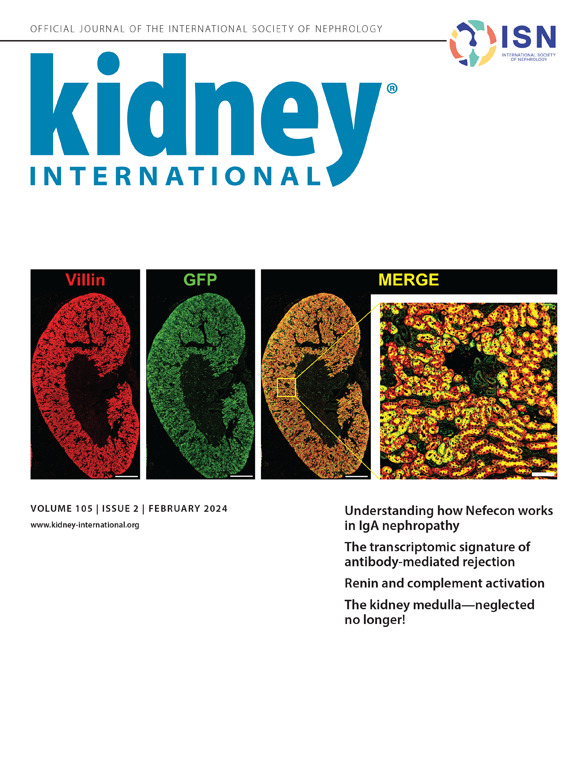嘌呤能受体 P2X7 以活性氧依赖的方式调节白细胞介素-1α介导的慢性肾脏病炎症。
IF 12.6
1区 医学
Q1 UROLOGY & NEPHROLOGY
引用次数: 0
摘要
慢性肾脏病(CKD)的发病、进展和心血管预后受到伴随而来的无菌性炎症的影响。促炎症细胞因子家族白细胞介素(IL)-1 在 CKD 中起着至关重要的作用,其中关键的警戒素 IL-1 还扮演着粘附分子的角色,可促进免疫细胞组织浸润,进而引发炎症。在这里,我们研究了钙离子和活性氧(ROS)对 IL-1 介导的炎症的不同方面的依赖性调控。我们发现,人类 CKD 单核细胞表现出嘌呤能钙离子特征的改变。当抑制 P2X7 时,单核细胞 IL-1 的释放会减少,其次是 P2X4,与健康人的单核细胞相比,这两个 ATP 受体被上调。在小鼠慢性肾功能衰竭模型中,删除 P2X7(P2X7-/-)会抑制 IL-1 的释放,但会增加骨髓衍生巨噬细胞对 IL-1 的表面呈递,并损害免疫细胞对肾脏的浸润,但不会保护肾功能。相反,在心肌梗塞模型中,野生型和 P2X7-/- 损伤心脏的免疫细胞浸润情况相当,与先前的肾损伤无关。野生型受体小鼠体内携带 P2X7-/- 免疫细胞的嵌合体小鼠系和反向设计的嵌合体小鼠系都表现出较少的急性炎症。然而,只有携带 P2X7-/- 免疫细胞的嵌合体小鼠对损伤引起的心脏重塑有明显的抵抗力。从机理上讲,ROS 测量显示 P2X7 诱导的线粒体 ROS 是单核细胞释放 IL-1 的重要因素。我们的研究揭示了 P2X7 在调节 IL-1 生物生成中的双重作用,其对炎症和炎症诱导的有害心脏重塑的影响可能会决定 CKD 治疗的临床结果。本文章由计算机程序翻译,如有差异,请以英文原文为准。

Purinergic receptor P2X7 regulates interleukin-1α mediated inflammation in chronic kidney disease in a reactive oxygen species-dependent manner
Onset, progression and cardiovascular outcome of chronic kidney disease (CKD) are influenced by the concomitant sterile inflammation. The pro-inflammatory cytokine family interleukin (IL)-1 is crucial in CKD with the key alarmin IL-1α playing an additional role as an adhesion molecule that facilitates immune cell tissue infiltration and consequently inflammation. Here, we investigate calcium ion and reactive oxygen species (ROS)-dependent regulation of different aspects of IL-1α-mediated inflammation. We show that human CKD monocytes exhibit altered purinergic calcium ion signatures. Monocyte IL-1α release was reduced when inhibiting P2X7, and to a lesser extent P2X4, two ATP-receptors that were found upregulated compared to monocytes from healthy people. In murine CKD models, deleting P2X7 (P2X7-/-) abolished IL-1α release but increased IL-1α surface presentation by bone marrow derived macrophages and impaired immune cell infiltration of the kidney without protecting kidney function. In contrast, immune cell infiltration into injured wild type and P2X7-/- hearts was comparable in a myocardial infarction model, independent of previous kidney injury. Both the chimeric mouse line harboring P2X7-/- immune cells in wild type recipient mice, and the inversely designed chimeric line showed less acute inflammation. However, only the chimera harboring P2X7-/- immune cells showed a striking resistance against injury-induced cardiac remodeling. Mechanistically, ROS measurements reveal P2X7-induced mitochondrial ROS as an essential factor for IL-1α release by monocytes. Our studies uncover a dual role of P2X7 in regulating IL-1α biogenesis with consequences for inflammation and inflammation-induced deleterious cardiac remodeling that may determine clinical outcomes in CKD therapies.
求助全文
通过发布文献求助,成功后即可免费获取论文全文。
去求助
来源期刊

Kidney international
医学-泌尿学与肾脏学
CiteScore
23.30
自引率
3.10%
发文量
490
审稿时长
3-6 weeks
期刊介绍:
Kidney International (KI), the official journal of the International Society of Nephrology, is led by Dr. Pierre Ronco (Paris, France) and stands as one of nephrology's most cited and esteemed publications worldwide.
KI provides exceptional benefits for both readers and authors, featuring highly cited original articles, focused reviews, cutting-edge imaging techniques, and lively discussions on controversial topics.
The journal is dedicated to kidney research, serving researchers, clinical investigators, and practicing nephrologists.
 求助内容:
求助内容: 应助结果提醒方式:
应助结果提醒方式:


